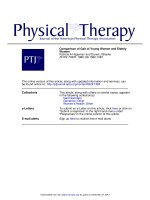ECG Notes: Interpretation and Management Guide_1 pdf
Bạn đang xem bản rút gọn của tài liệu. Xem và tải ngay bản đầy đủ của tài liệu tại đây (7.01 MB, 207 trang )
/>Contacts • Phone/E-Mail
Name:
Ph: e-mail:
Name:
Ph: e-mail:
Name:
Ph: e-mail:
Name:
Ph: e-mail:
Name:
Ph: e-mail:
Name:
Ph: e-mail:
Name:
Ph: e-mail:
Name:
Ph: e-mail:
Name:
Ph: e-mail:
Name:
Ph: e-mail:
Name:
Ph: e-mail:
Name:
Ph: e-mail:
00ECG-FM 2/10/05 7:45 PM Page 2
Copyright © 2005 F. A. Davis.
F. A. Davis Company • Philadelphia
ECG
N
otes
Purchase additional copies of this book
at your health science bookstore or
directly from F. A. Davis by shopping
online at www.fadavis.com or by calling
800-323-3555 (US) or 800-665-1148 (CAN)
A Davis’s Notes Book
Shirley A. Jones, MS Ed, MHA, EMT-P
Interpretation and Management Guide
ECG
N
otes
Interpretation and Management Guide
00ECG-FM 2/10/05 7:45 PM Page i
Copyright © 2005 F. A. Davis.
F. A. Davis Company
1915 Arch Street
Philadelphia, PA 19103
www.fadavis.com
Copyright © 2005 by F. A. Davis Company
All rights reserved. This book is protected by copyright. No part of it may be
reproduced, stored in a retrieval system, or transmitted in any form or by any
means, electronic, mechanical, photocopying, recording, or otherwise, with-
out written permission from the publisher.
Printed in China by Imago
Last digit indicates print number: 10 9 8 7 6 5 4 3 2 1
Publisher, Nursing: Lisa Deitch
Project Editor: Ilysa H. Richman
Developmental Editor: Anne-Adele Wight
Design Manager: Joan Wendt
Cover Design: Paul Fry
Consultant: Dawn McKay, RN, MSN, CCRN
As new scientific information becomes available through basic and clinical
research, recommended treatments and drug therapies undergo changes. The
author(s) and publisher have done everything possible to make this book
accurate, up to date, and in accord with accepted standards at the time of
publication. The author(s), editors, and publisher are not responsible for
errors or omissions or for consequences from application of the book, and
make no warranty, expressed or implied, in regard to the contents of the book.
Any practice described in this book should be applied by the reader in accor-
dance with professional standards of care used in regard to the unique
circumstances that may apply in each situation. The reader is advised always
to check product information (package inserts) for changes and new informa-
tion regarding dose and contraindications before administering any drug.
Caution is especially urged when using new or infrequently ordered drugs.
Authorization to photocopy items for internal or personal use, or the internal
or personal use of specific clients, is granted by F. A. Davis Company for users
registered with the Copyright Clearance Center (CCC) Transactional Reporting
Service, provided that the fee of $.10 per copy is paid directly to CCC, 222
Rosewood Drive, Danvers, MA 01923. For those organizations that have been
granted a photocopy license by CCC, a separate system of payment has been
arranged. The fee code for users of the Transactional Reporting Service is:
8036-1347-4/05 0 + $.10.
00ECG-FM 2/10/05 7:45 PM Page ii
Copyright © 2005 F. A. Davis.
BASICS ECGS 12-LEAD MEDS/
SKILLS
CPR ACLS TEST
STRIPS
TOOLS
Waterproof and Reusable
Wipe-Free Pages
Write directly onto any page of ECG Notes with
a ballpoint pen. Wipe old entries off with an
alcohol pad and reuse.
Place 2
7
/
8
ϫ2
7
/
8
Sticky Notes here
for a convenient and refillable note pad
HIPAA Compliant
OSHA Compliant
✓
✓
00ECG-FM 2/10/05 7:45 PM Page iii
Copyright © 2005 F. A. Davis.
Look for our other
Davis’s Notes titles
Available Now!
RNotes
®
: Nurse’s Clinical Pocket Guide
ISBN: 0-8036-1060-2
LPN Notes: Nurse’s Clinical Pocket Guide
ISBN: 0-8036-1132-3
MedNotes: Nurse’s Pharmacology Pocket Guide
ISBN: 0-8036-1109-9
MedSurg Notes: Nurse’s Clinical Pocket Guide
ISBN: 0-8036-1115-3
NutriNotes: Nutrition & Diet Therapy Pocket Guide
ISBN: 0-8036-1114-5
IV Therapy Notes: Nurse’s Clinical Pocket Guide
ISBN: 0-8036-1288-5
PsychNotes: Clinical Pocket Guide
ISBN: 0-8036-1286-9
LabNotes: Pocket Guide to Lab & Diagnostic Tests
ISBN: 0-8036-1265-6
OrthoNotes: A Clinical Examination Pocket Guide
ISBN: 0-8036-1350-4
MA Notes: Medical Assistant’s Pocket Guide
ISBN: 0-8036-1281-8
00ECG-FM 2/10/05 7:45 PM Page iv
Copyright © 2005 F. A. Davis.
1
BASICS
Anatomy of the Heart
The heart, located in the mediastinum, is the central structure of
the cardiovascular system. It is protected by the bony structures
of the sternum anteriorly, the spinal column posteriorly, and the
rib cage.
♥ Clinical Tip: The cone-shaped heart has its tip (apex) just
above the diaphragm to the left of the midline. This is why we
may think of the heart as being on the left side, since the
strongest beat can be heard or felt here.
01ECG-Tab 01 2/4/05 3:57 PM Page 1
Copyright © 2005 F. A. Davis.
2
BASICS
Endocardium
Parietal
pericardium
Myocardium
(heart muscle)
Epicardium
(visceral pericardium)
Fibrous pericardium
(pericardial sac)
Pericardial cavity
Layers of the Heart
The pericardial cavity contains a small amount of lubricating fluid to
prevent friction during heart contraction.
01ECG-Tab 01 2/4/05 3:57 PM Page 2
Copyright © 2005 F. A. Davis.
3
BASICS
Pulmonary semilunar
valve
Aortic semilunar
valve
Tricuspid
valve
Fibrous
skeleton
Mitral valve
Posterior
Coronary artery
Heart Valves
Properties of Heart Valves
■ Fibrous connective tissue prevents enlargement of valve
openings and anchors valve flaps.
■ Valve closure prevents backflow of blood during and after
contraction.
The atria have been removed in this superior view.
01ECG-Tab 01 2/4/05 3:57 PM Page 3
Copyright © 2005 F. A. Davis.
4
BASICS
Brachiocephalic
artery
Superior vena cava
Left common carotid artery
Left subclavian artery
Aortic arch
Right
pulmonary artery
Right
pulmonary veins
Right atrium
Inferior vena cava
Tricuspid
valve
Pulmonary
semilunar valve
Left pulmonary artery
Left atrium
Left pulmonary veins
Mitral valve
Left ventricle
Aortic semilunar
valve
Interventricular
septum
Apex
Chordae
tendineae
Right
ventricle
Papillary
muscles
Heart Chambers and Great Vessels
01ECG-Tab 01 2/4/05 3:57 PM Page 4
Copyright © 2005 F. A. Davis.
5
BASICS
Aorta
Left coronary artery
Anterior
descending branch
Coronary sinus
Posterior
artery and
vein
Small
cardiac vein
Right coronary artery
A
B
Circumflex branch
Great cardiac
vein
Right coronary vein
Coronary Arterial Circulation
(A) Anterior view
(B) Posterior view
01ECG-Tab 01 2/4/05 3:57 PM Page 5
Copyright © 2005 F. A. Davis.
6
Anatomy of the Cardiovascular System
The cardiovascular system is a closed system consisting of
blood vessels and the heart. Arteries and veins are connected
by smaller structures in which electrolytes are exchanged
across cell membranes.
Blood Vessel Structures
BASICS
Tunica
externa
External elastic
lamina
Tunica
media
Internal elastic
lamina
Endothelium (lining)
Artery
Arteriole
Endothelial
cells
Smooth
muscle
Precapillary
sphincter
Capillary
Blood flow
Venule
Vein
Valve
Tunica
intima
Tunica
externa
Tunica
media
01ECG-Tab 01 2/4/05 3:57 PM Page 6
Copyright © 2005 F. A. Davis.
7
Arterial Circulation
Arteries (excluding the pulmonary artery) transport oxygenated blood.
BASICS
Occipital
Internal carotid
Vertebral
Brachiocephalic
Aortic arch
Maxillary
Facial
External carotid
Common carotid
Subclavian
Axillary
Pulmonary
Celiac
Left gastric
Hepatic
Splenic
Superior
mesenteric
Abdominal aorta
Right common
iliac
Internal iliac
External iliac
Femoral
Popliteal
Anterior tibial
Posterior tibial
Intercostal
Brachial
Renal
Gonadal
Inferior mesenteric
Radial
Ulnar
Deep palmar arch
Superficial
palmar arch
Deep femoral
01ECG-Tab 01 2/4/05 3:58 PM Page 7
Copyright © 2005 F. A. Davis.
8
BASICS
Superior sagittal sinus
Inferior sagittal sinus
Straight sinus
Transverse sinus
Vertebral
External jugular
Internal jugular
Subclavian
Brachiocephalic
Pulmonary
Hepatic
Hepatic portal
Left gastric
Renal
Splenic
Inferior
mesenteric
Internal iliac
Femoral
External iliac
Great saphenous
Popliteal
Small saphenous
Anterior tibial
Anterior facial
Superior vena cava
Axillary
Cephalic
Hemiazygos
Intercostal
Inferior vena cava
Brachial
Basilic
Gonadal
Superior
mesenteric
Dorsal arch
Volar digital
Dorsal arch
Common iliac
Venous Circulation
Veins (excluding the pulmonary vein) carry blood low in oxygen and high
in carbon dioxide.
01ECG-Tab 01 2/4/05 3:58 PM Page 8
Copyright © 2005 F. A. Davis.
Physiology of the Heart
Mechanics of Heart Function
Process Action
Cardiac cycle
Systole
Diastole
Stroke
volume (SV)
Cardiac
output (CO)
Properties of Cardiac Cells
Property Ability
Automaticity
Excitability
Conductivity
Contractility
9
BASICS
Sequence of events in 1 heartbeat. Blood is
pumped through the entire cardiovascular
system.
Contraction phase—usually refers to
ventricular contraction.
Relaxation phase—the atria and ventricles are
filling. Lasts longer than systole.
Amount of blood ejected from either ventricle
in a single contraction. Starling’s Law of the
Heart states that degree of cardiac muscle
stretch can increase force of ejected blood.
More blood filling the ventricles ↑ SV.
Amount of blood pumped through the
cardiovascular system per min.
CO ϭ SV ϫ Heart rate (HR)
Generates electrical impulse independently,
without involving the nervous system.
Responds to electrical stimulation.
Passes or propagates electrical impulses
from cell to cell.
Shortens in response to electrical
stimulation.
01ECG-Tab 01 2/4/05 3:58 PM Page 9
Copyright © 2005 F. A. Davis.
10
BASICS
Dominant pacemaker of the heart, located in
upper portion of right atrium. Intrinsic rate
60–100 bpm.
Direct electrical impulses between SA and AV
nodes.
Part of AV junctional tissue. Slows
conduction, creating a slight delay before
impulses reach ventricles. Intrinsic rate
40–60 bpm.
Transmits impulses to bundle branches.
Located below AV node.
Conducts impulses that lead to left ventricle.
Conducts impulses that lead to right ventricle.
Network of fibers that spreads impulses
rapidly throughout ventricular walls.
Located at terminals of bundle branches.
Intrinsic rate 20–40 bpm.
Bundle of His
Left bundle
branch
Purkinje
fibers
Right bundle
branch
AV Node
SA node
Internodal
pathways
Electrical Conduction System of the Heart
Conduction System Structures and Functions
Structure Function and Location
Sinoatrial (SA)
node
Internodal
pathways
Atrioventricular
(AV) node
Bundle of His
Left bundle
branch
Right bundle
branch
Purkinje system
Conduction system of the heart.
01ECG-Tab 01 2/4/05 3:58 PM Page 10
Copyright © 2005 F. A. Davis.
Electrical Conduction System of the Heart
Electrophysiology
Action Effect
Depolarization The electrical charge of a cell is altered
by a shift of electrolytes on either side
of the cell membrane. This change
stimulates muscle fiber to contract.
Repolarization Chemical pumps re-establish an internal
negative charge as the cells return to
their resting state.
Depolarization and
repolarization of the heart.
♥ Clinical Tip: Mechanical
and electrical functions of
the heart are influenced by
proper electrolyte balance.
Important components of
this balance are sodium,
calcium, potassium, and
magnesium.
11
BASICS
P
R
T
Q
S
Ventricular
depolarization
Ventricular
repolarization
Atrial
depolarization
01ECG-Tab 01 2/4/05 3:58 PM Page 11
Copyright © 2005 F. A. Davis.
12
BASICS
The Electrocardiogram (ECG)
■ An ECG is a series of waves and deflections recording the
heart’s electrical activity from a certain “view.”
■ Many views, each called a lead, monitor voltage changes
between electrodes placed in different positions on the body.
■ Leads I, II, and III are bipolar leads, which consist of two
electrodes of opposite polarity (positive and negative). The
third (ground) electrode minimizes electrical activity from
other sources.
■ Leads aVR, aVL, and aVF are unipolar leads and consist of a
single positive electrode and a reference point (with zero
electrical potential) that lies in the center of the heart’s
electrical field.
■ Leads V
1
–V
6
are unipolar leads and consist of a single positive
electrode with a negative reference point found at the
electrical center of the heart.
■ Voltage changes are amplified and visually displayed on an
oscilloscope and graph paper.
■ An ECG tracing looks different in each lead because the
recorded angle of electrical activity changes with each lead.
■ Several different angles allow a more accurate perspective
than a single one would.
■ The ECG machine can be adjusted to make any skin electrode
positive or negative. The polarity depends on which lead the
machine is recording.
■ A cable attached to the patient is divided into several
different-colored wires: three, four, or five for monitoring
purposes, or ten for a 12-lead ECG.
■ Incorrect placement of electrodes may turn a normal ECG
tracing into an abnormal one.
♥ Clinical Tip: Patients should be treated according to their
symptoms, not merely their ECG.
♥ Clinical Tip: To obtain a 12-lead ECG, four wires are attached
to each limb and six wires are attached at different locations on
the chest. The total of ten wires provides twelve views (12
leads).
01ECG-Tab 01 2/4/05 3:58 PM Page 12
Copyright © 2005 F. A. Davis.
13
Limb Leads
Electrodes are placed on the right arm (RA), left arm (LA), right
leg (RL), and left leg (LL). With only four electrodes, six leads
are viewed.
■ Standard leads: I, II, III
■ Augmented leads: aVR, aVL, aVF
Standard Limb Lead Electrode Placement
BASICS
LARA
or
RL LL
RA LA
LLRL
01ECG-Tab 01 2/4/05 3:58 PM Page 13
Copyright © 2005 F. A. Davis.
14
BASICS
I
IIIII
LL
RA LA
Standard Limb Leads
Elements of Standard Limb Leads
Positive Negative View of
Lead Electrode Electrode Heart
ILARALateral
II LL RA Inferior
III LL LA Inferior
01ECG-Tab 01 2/4/05 3:58 PM Page 14
Copyright © 2005 F. A. Davis.
Augmented Limb Leads
Elements of Augmented Limb Leads
Lead Positive Electrode View of Heart
aVR RA None
aVL LA Lateral
aVF LL Inferior
15
BASICS
LL
RA LA
aVR
aVL
aVF
01ECG-Tab 01 2/4/05 3:58 PM Page 15
Copyright © 2005 F. A. Davis.
16
BASICS
Midclavicular
line
V
1
V
2
V
3
V
4
V
5
V
6
Anterior
axillary line
Midaxillary
line
Chest Leads
Standard Chest Lead Electrode Placement
Elements of Chest Leads
Lead Positive Electrode Placement View of Heart
V
1
4th Intercostal space to Septum
right of sternum
V
2
4th Intercostal space to Septum
left of sternum
V
3
Directly between V
2
and V
4
Anterior
V
4
5th Intercostal space at Anterior
left midclavicular line
V
5
Level with V
4
at left anterior Lateral
axillary line
V
6
Level with V
5
at left midaxillary line Lateral
01ECG-Tab 01 2/4/05 3:58 PM Page 16
Copyright © 2005 F. A. Davis.
17
Electrode Placement Using a 3-Wire Cable
Electrode Placement Using a 5-Wire Cable
♥ Clinical Tip: Five-wire telemetry units are commonly used to monitor
leads I, II, III, aVR, aVL, aVF, and V
1
in critical care settings.
BASICS
RA LA
LL
RA LA
LLRL
V
1
01ECG-Tab 01 2/4/05 3:58 PM Page 17
Copyright © 2005 F. A. Davis.
18
BASICS
G
G
Modified Chest Leads
■ Modified chest leads (MCL) are useful in detecting bundle branch
blocks and premature beats.
■ Lead MCL
1
simulates chest lead V
1
and views the ventricular septum.
■ Lead MCL
6
simulates chest lead V
6
and views the lateral wall of the left
ventricle.
Lead MCL
1
electrode placement.
Lead MCL
6
electrode placement.
♥ Clinical Tip: Write on the rhythm strip which simulated lead
was used.
01ECG-Tab 01 2/4/05 3:58 PM Page 18
Copyright © 2005 F. A. Davis.
19
The Right-Sided 12-Lead ECG
■ The limb leads are placed as usual but the chest leads are a
mirror image of the standard 12-lead chest placement.
■ The ECG machine cannot recognize that the leads have been
reversed. It will still print “V
1
–V
6
” next to the tracing. Be sure
to cross this out, and write the new lead positions on the ECG
paper.
The Right-Sided 12-Lead ECG
Chest Leads Position
V
1R
4th Intercostal space to left of sternum
V
2R
4th Intercostal space to right of sternum
V
3R
Directly between V
2R
and V
4R
V
4R
5th Intercostal space at right midclavicular line
V
5R
Level with V
4R
at right anterior axillary line
V
6R
Level with V
5R
at right midaxillary line
♥ Clinical Tip: Patients with an acute inferior MI should have
right-sided ECGs to assess for possible right ventricular
infarction.
BASICS
Midclavicular
line
Anterior
axillary line
Midaxillary
line
V
6R
V
4R
V
5R
V
1R
V
2R
V
3R
01ECG-Tab 01 2/4/05 3:58 PM Page 19
Copyright © 2005 F. A. Davis.









